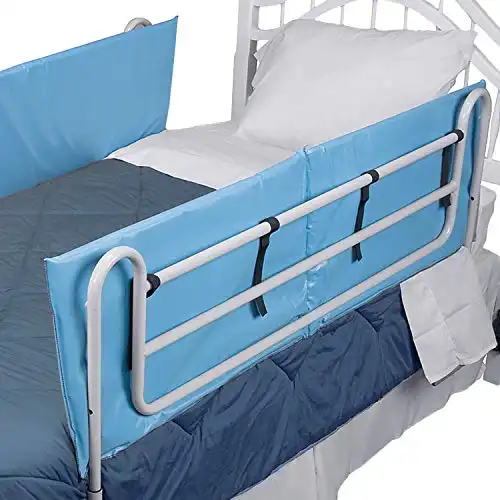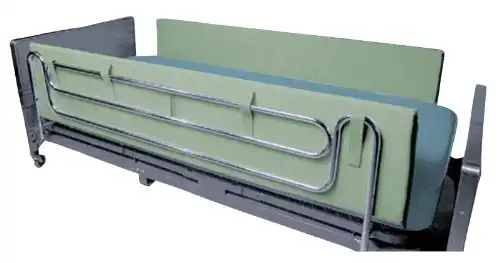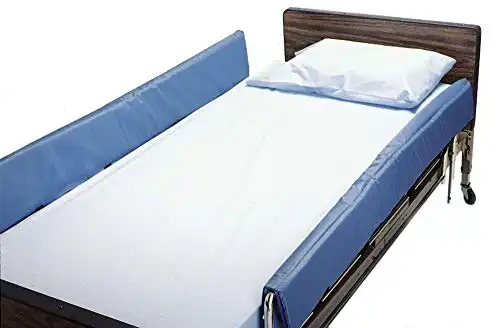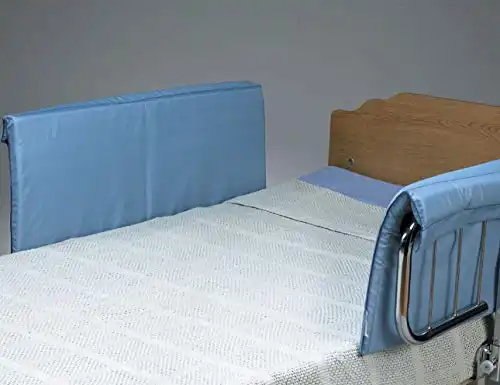We have reviewed the best bed rail pads for the elderly. If you are in a hurry, the table below gives a quick snapshot. Or you can scroll down for detailed reviews.
|
$40.28
|
$72.69
|
N/A
|
N/A
|
Contents
What are Bed Rail Pads?
Bed rail pads have two main purposes: they protect patients from bed entrapment and prevent trauma injuries to patients suffering from anxiety, dementia, skin breakdown, or restlessness.
While bed rails are extremely effective in fall prevention for patients confined to bed, there are several tight spaces around a bed rail where vulnerable patients who are trying to get out of or move within, the bed can get trapped by their neck, head, or chest. Bed rail pads and protectors ensure that such entrapment does not occur.
At the same time, patients with dementia and those facing anxiety attacks or seizures are prone to feel like they have been caged when lying in a bed that has rails on both sides. They might feel the urge to push themselves out of the bed either through the rails or from the sides. For such patients, bed rail pads can help prevent injuries and reduce the risk of panic attacks.
How are Bed Rail Pads used?
The FDA has identified 7 zones of entrapment in and around bed rails. It has also issued guidelines and observations on how to prevent injuries in patients due to entrapment.
Among the 7 zones, the rail pads can address zones 1,4,5 and 6, which are explained below:
Zone1 (Within the Rail): Any open space that has a size of more than 4.75 inches between the top and bottom end of the rails can potentially cause the patients’ head to get trapped. Rail Pads close out this area and therefore prevent head entrapment.
Zone 4 (Under the Rail): If there is a gap between the lowest edge of the rail and the mattress of more than 2 ⅜ inches, there is potential scope for neck entrapment. Bed rail pads can be used to fit snugly between the rails and the mattress to prevent this from happening.
Zone 5 (Between Split bed rails): If your loved one’s bed has partial length split rails and the space between the head and bottom rail is too large, there is a risk of neck or chest entrapment. Use bed rail pads to cover the gap between the top and bottom rails.
Zone 6 (Between the end of the rail and the side edge of the head or footboard): A gap between the end of the rail and headboard or footboard can also be a risk of entrapment. Use a rail pad to cover the gap and close it out.
Zone 7 (Between the head or footboard and the end of the mattress): The gap between the mattress end and the headboard or footboard can also cause entrapment. The gap can be filled with rail pads.
You may also like Devices and Apparatus for Turning a Patient in Bed
What to Consider When Buying a Bed Rail Pad?
While most bed rail pads perform the same function, the important difference between them lies in the design. There is a large variety of options available, and each offers unique benefits that meet the varying needs of your loved one. Below we list the major designs of bed rail pads and the function that they perform.
Padding: For patients that are easily agitated, are facing dementia wandering or are ataxic, make sure to buy bed rail pads that are padded at all ends, including even the outer portion and the top of the rail pad. This helps to prevent inadvertent injury when the patient tries to wander out of the bed rail.
Cleanability: Ensure to buy a bed rail pad that is easy to wipe clean. This helps reduce the possibility of cross-contamination and makes it easy for the caregiver to clean the rail pad on a regular basis.
Split- Rail Models: If your loved one needs only the top of the bed rail during the day but you also use a separate bottom rail during the nights, a split-rail model can be used to cover the two rails separately and individually as well.
Window models: Having bed rail pads have a disadvantage – they cut off the line of sight of the patient, especially if they are unable to sit themselves up. This can agitate patients who are prone to anxiety or are confused. To prevent this, there are models available in the market that have a window in them. Not only do they help make the patients less agitated, but they also make it easier for the caregiver to monitor the patient without disturbing them.
Limb Entanglement: There are several complementary products to bed rail pads that help to reduce the risk of limb entanglements, such as gap stuffers and bed bolster wedges.
You may also like Bedroom Aids for the Elderly
Best Bed Rail Pads for the Elderly
#1 DMI Bed Rail Bumper Pad
Duro Med is a premium and reputable manufacturer of adaptable products for use by the elderly. The DMI bed rail bumper pads are helpful in preventing injuries in patients who are confined to a bed.

These rail bumper pads are cushioned for extra protection. The size is 60 X 15 X 0.5 inches, which is perfect for most hospital beds. The pads are made from durable polyfoam which provides for strong cushioning protection as your loved one moves in the bed. The pads are useful even for patients who experience seizures.
There is a vinyl cover on the pads which is non-allergenic and flame retardant. It is easy to clean using mild soap and lukewarm water.
The pads are easy to install and can be easily secured to the rails with hook and loop straps.
Pros
- Cushioned Pads for extra protection
- Durable, made from polyfoam
- Non-allergenic and flame retardant vinyl cover
- Easy to install.
Cons
- The pads are taller than the rails. This is inconvenient for patients who hold the top of the rails for adjusting their position.
- Not useful for half rail beds
You may also like Best Bariatric Bed for Home Use
#2 Drive Medical Foam Side Rail Bumper Pads
Drive Medical is another very popular manufacturer of adaptive equipment for seniors.

The Drive Medical side rail bumpers are made from high-density foam, which creates a safe and cosy environment for the patient and protects them from getting injured or trapped in the bed.
Each pair has a fluid-resistant vinyl cover which is easy to clean with mild soap and lukewarm water. There are hook and loop fasteners to secure the rail pads in place.
The product dimensions are 72 X 14 X 1.5 inches, which covers the bed from headboard to footboard (not just the railings). The recommended maximum weight capacity of these pads is 400 pounds, which is enough for most patients.
Pros
- Full length (72 inches) cover most part of the bed
- Fluid resistant and easy to wash vinyl cover
- High-density 1.5-inch thick padding for safety
- Max weight capacity of 400 pounds
Cons
- The pads are too easily removable for patients with dementia
- The bed height cannot be adjusted with the pads on
#3 SkiL-Care Vinyl Bed Rail Pads
SkiL-Care bed rail pads provide cushioning at the top of the rail and on the patient side of the rails. The pads also extend below the mattress for extra protection.
No products found.The foam padding of the rail pads is thick and comfortable. There is a vinyl cover on the rail pads that is non-allergenic, mildew-resistant and bacteria resistant. The vinyl cover is easy to wipe clean for daily use.
These rail pads are available in 3 different sizes based on the size of the bed. The rail pads can be easily affixed to the bed rails with velcro straps.
Pros
- Available in 3 sizes as per your need
- Affixes easily to the railing using velcro straps
- Thick foam padding for extra protection
- Provides protection at the top of the rail and extends below the mattress as well
Cons
- The pads are not useful for half rails
No products found.
You may also like Best Bed Frames For Seniors
#4 Anti Entrapment Bed Rail Pads
Another set of bed rail pads from SkiL-Care, are meant for half rails and include two pads that are each 13 x 35 inches in dimension.

The pads have a hook and loop strap arrangement at the top for installing them. They are fabricated with extra material, which means they can accommodate up to 15 x 37-inch length if needed.
The railings are covered in vinyl for easy wash and care.
Pros
- Inexpensive
- Meant for half rails
- Vinyl-covered, for easy wash and care
Cons
- These do not have any padding for extra protection
You may also like Best Bed Sheets For Elderly
Conclusion
Bed rail pads are devices that help reduce the chance of entrapment between the bed rails and the bed for patients who are largely confined to the bed. They also help secure patients who are prone to anxiety or dementia walking.
There are several types of bed rail pads, such as ones with windows and those that can be used with half rails as well. The 4 options that we have covered in this article are useful for most requirements and are the best rail pads available in the market.




